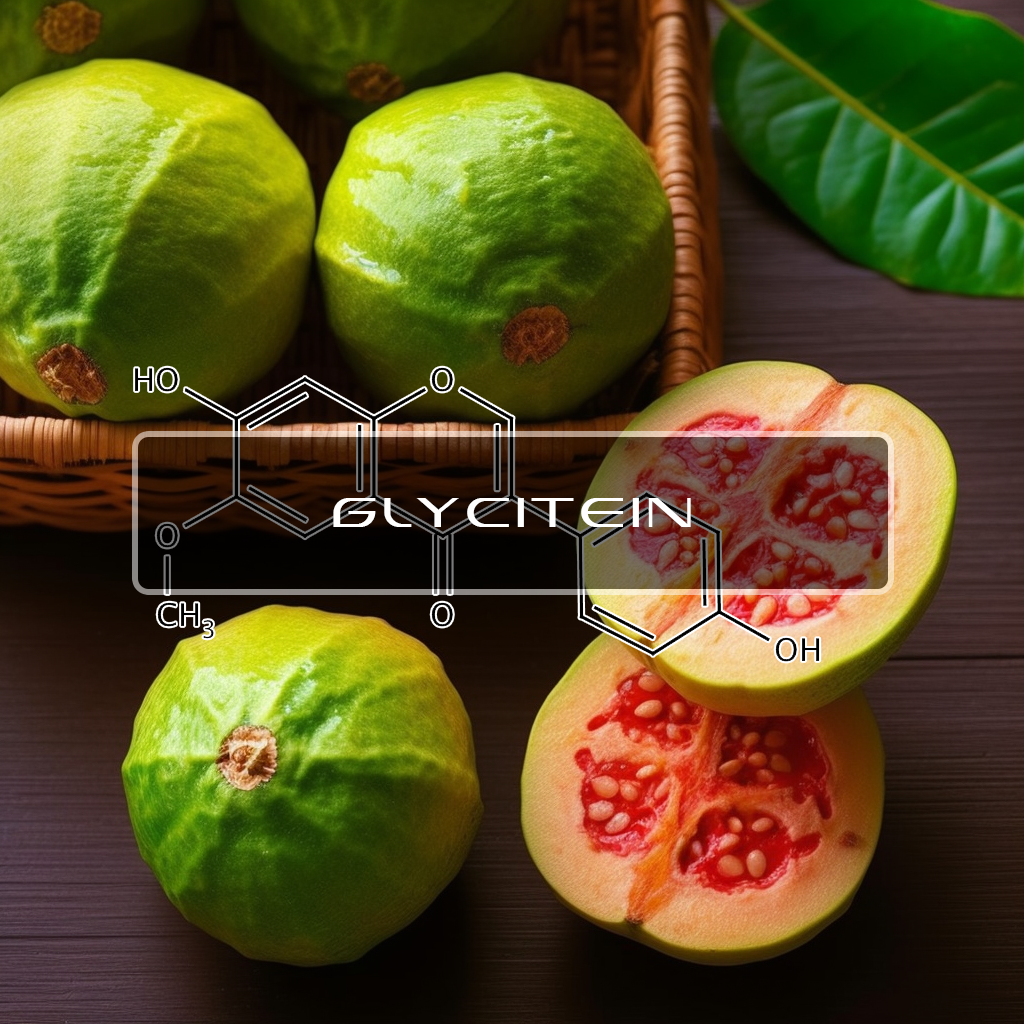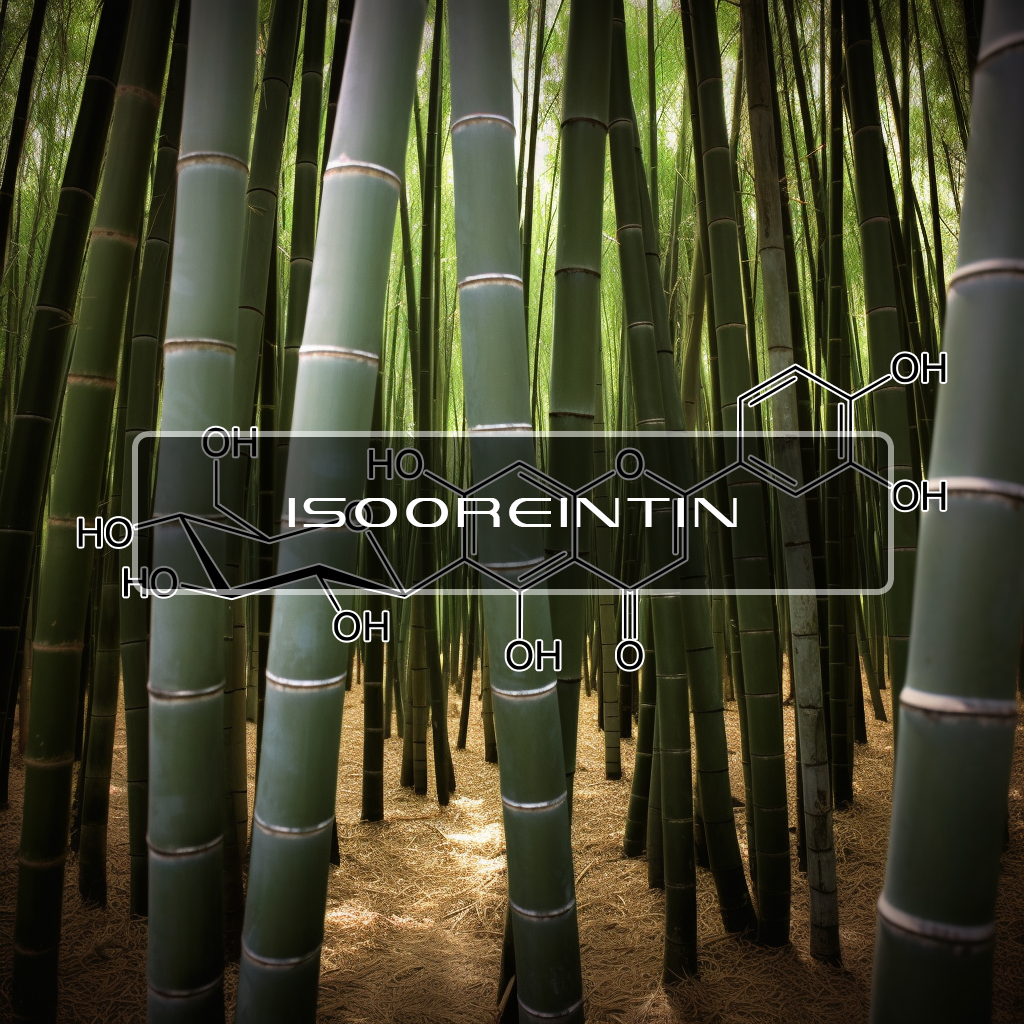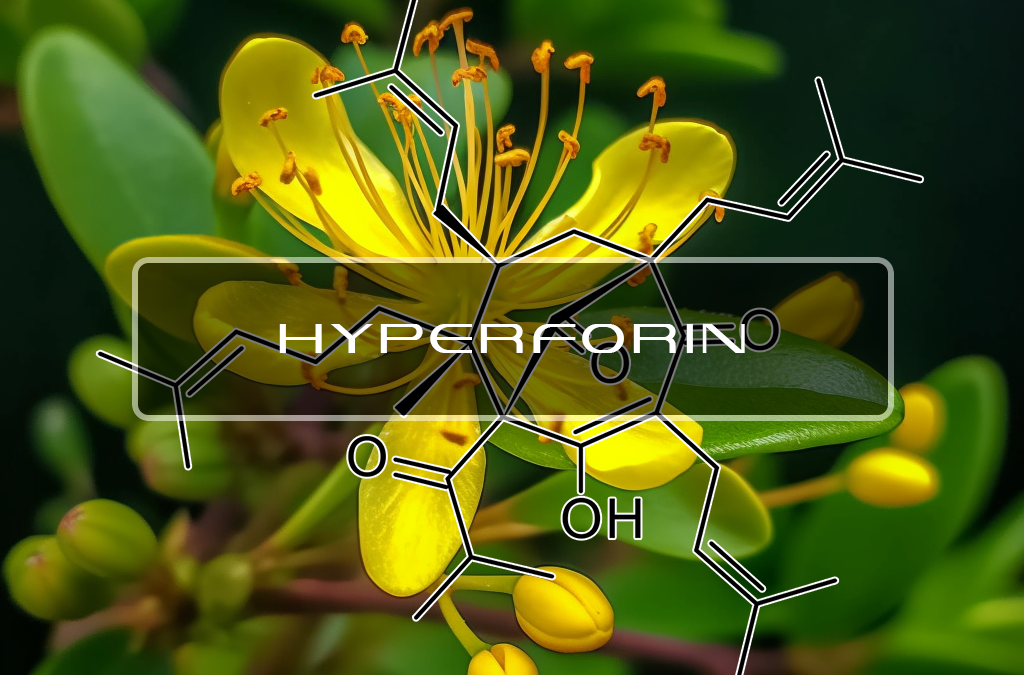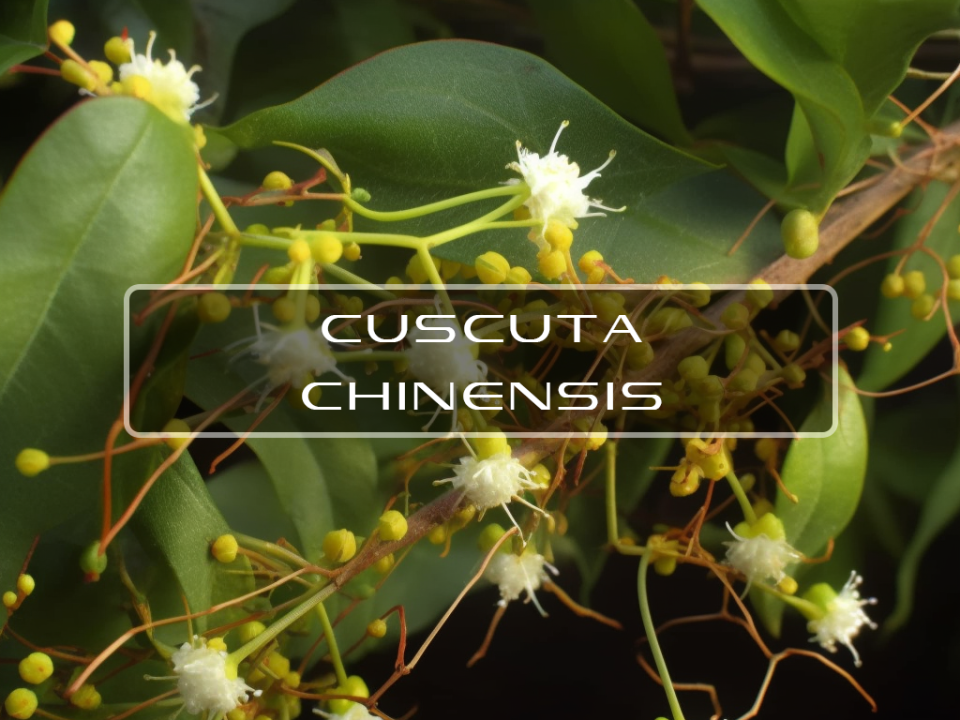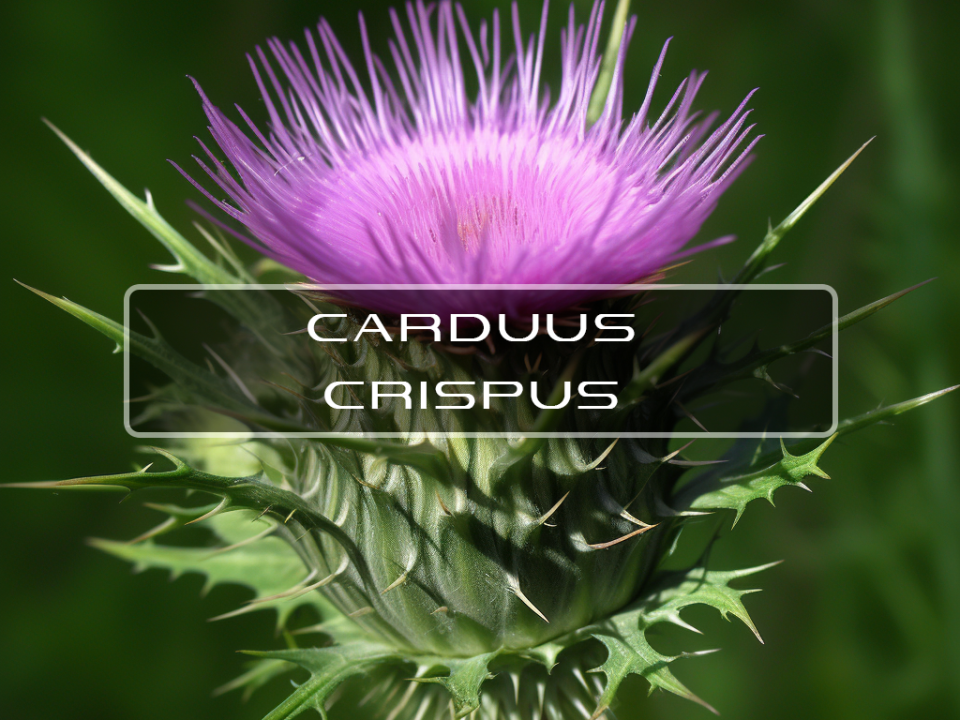Glycitein
February 19, 2020Isoorientin
February 19, 2020- A Chiral‐Pool‐Based Approach To The Core Structure Of (+)‐Hyperforin
- A Concise Approach Towards The Bicyclo [3.3. 1] Nonan-9-One Core Present In The Phloroglucin Natural Product Hyperforin
- A Simple And Reliable Semipreparative High-Performance Liquid Chromatography Technique For The Isolation Of Marker-Grade Hyperforin From Hypericum Perforatum L …
- Abstract# 122: Mechanisms Of Hyperforin As An Anti-Angiogenic Angioprevention Agent
- Activation Of Nonselective Cation Channels By Hyperforin–A Novel Mechanism Of Antidepressant Activity
- Activity Profiles Of Two Hyperforin-Containing Hypericum Extracts In Behavioral Models
- Acute And Chronic Actions Of A Dry Methanolic Extract Of Hypericum Perforatum And A Hyperforin-Rich Extract On Dopaminergic And Serotonergic Neurones In Rat Nucleus …
- AdHyperforin: A Homologue Of Hyperforin From Hypericum Perforatum
- Advances In Studies On Synthesis And Neuropharmacology Of Hyperforin And Its Derivatives
- An In Vitro And Hydroponic Growing System For Hypericin, Pseudohypericin, And Hyperforin Production Of St. John’S Wort (Hypericum Perforatum Cv New Stem)
- And Biopharmaceutics Stabilization Of Hyperforin Dicyclohexylammonium Salt With Dissolved Albumin And Albumin Nanoparticles For Studying Hyperforin E Ff Ects …
- Antibacterial Activity Of Hyperforin From St John’S Wort
- Antibacterial Activity Of Hyperforin From St John’S Wort, Against Multiresistant Staphylococcus Aureus And Gram-Positive Bacteria
- Anticancer And Antibacterial Activity Of Hyperforin And Its Derivatives
- Antidepressant Activity Of Hyperforin Conjugates Of The St.John’S Wort, Hypericum Perforatum Linn.: An Experimental Study
- Antidepressant Activity Of Hypericum Perforatum And Hyperforin: The Neglected Possibility
- Antidepressant Hyperforin Up-Regulates Vegf In Cns Tumour Cells
- Antidepressant-Like Activity Of Hyperforin And Changes In Bdnf And Zinc Levels In Mice Exposed To Chronic Unpredictable Mild Stress
- Anti-Proliferative And Anti-Migratory Effects Of Hyperforin In 2D And 3D Artificial Constructs Of Human Dermal Fibroblasts–A New Option For Hypertrophic Scar Treatment?
- Antistress And Antioxidant Activity In Mice After Repeated Treatment With St. John’S Wort Extracts Of Different Hyperforin Content
- Arbuscular Mycorrhizal Fungi Altered The Hypericin, Pseudohypericin, And Hyperforin Content In Flowers Of Hypericum Perforatum Grown Under Contrasting P Availability …
- Aristoforin, A Novel Stable Derivative Of Hyperforin, Is A Potent Anticancer Agent
- Biological Evaluation Of Hyperforin And Its Hydrogenated Analogue On Bacterial Growth And Biofilm Production
- Biosynthesis Of Hyperforin And AdHyperforin From Amino Acid Precursors In Shoot Cultures Of Hypericum Perforatum
- Biosynthesis Of Hyperforin In Hypericum Perforatum
- Biosynthetic And Total Synthetic Approaches For (+)-Hyperforin: A Potent Antidepressant Agent From Hypericum Perforatum Linn.(St. John’S Wort)
- Biotechnological Production Of Hyperforin For Pharmaceutical Formulation
- Catalytic Asymmetric Total Synthesis Of Ent‐Hyperforin
- Cellular And Molecular Effects Of The Antidepressant Hyperforin On Brain Cells: Review Of The Literature
- Chemical Unstability And Pharmacological Activity Of Hyperforin
- Chemistry And Biology Of The Polycyclic Polyprenylated Acylphloroglucinol Hyperforin
- Chemistry Of St. John’S Wort: Hypericin And Hyperforin
- Clinical Significance Of Hyperforin For The Efficacy Of Hypericum Extracts On Depressive Disorders Of Different Severities
- Comparison Of Methods For The Exhaustive Extraction Of Hypericins, Flavonoids, And Hyperforin From Hypericum Perforatum L.
- Computed Regioselectivity And Conjectured Biological Activity Of Ene Reactions Of Singlet Oxygen With The Natural Product Hyperforin
- Construction Of Highly Functionalized Medium‐Sized Rings: Synthesis Of Hyperforin And Perforatumone Model Systems
- Content Of Antidepressant Hyperforin Correlates With Translucent Glands In Hypericum Perforatum L.
- Correlation Of Hyperforin Content Of Hypericum Perforatum (St John’S Wort) Extracts With Their Effects On Alcohol Drinking In C57Bl/6J Mice: A Preliminary Study
- Cover Picture: Oxidative Fragmentation Of The Bridged Β‐Triketone Core Of Hyperforin (Eur. J. Org. Chem. 6/2004)
- Cover Picture: Phloroglucinol Derivatives Guttiferone G, Aristoforin, And Hyperforin: Inhibitors Of Human Sirtuins Sirt1 And Sirt2 (Angew. Chem. Int. Ed. 27/2007)
- Cyp3A-Inducing Effect Of Hyperforin And Derivatives In Rodents
- Design And Synthesis Of Novel Hyperforin Analogues-Fascinating Skeletal Rearrangements Of Polycyclic Polyprenylated Acylphloroglucinols Core
- Detection Of Hyperforin In Turkish Species Of Hypericum (Guttiferae)
- Determination Of Hyperforin In Human Plasma Using Solid-Phase Extraction And High-Performance Liquid Chromatography With Ultraviolet Detection
- Determination Of Hyperforin In Mouse Brain By High-Performance Liquid Chromatography/Tandem Mass Spectrometry
- Determination Of Hyperforin, Hypericin, And Pseudohypericin In Human Plasma Using High-Performance Liquid Chromatography Analysis With Fluorescence And …
- Determination Of Hypericin And Hyperforin Content In Different Phytopharmaceuticals And Dietary Supplements Containing Hypericum Perforatum Extract
- Determination Of Hypericin And Hyperforin Content In Selected Jordanian Hypericum Species
- Development Of A High-Performance Liquid Chromatographic Method With Electrochemical Detection For The Determination Of Hyperforin
- Development Of A Simple, Rapid And Reproducible Hplc Assay For The Simultaneous Determination Of Hypericins And Stabilized Hyperforin In Commercial St. John’S Wort …
- Differential Accumulation Of Hyperforin And SecoHyperforin In Hypericum Perforatum Tissue Cultures
- Divergent Effects Of Hyperforin On The Release Of Arachidonic Acid In Human Platelets And Polymorphonuclear Leukocytes
- Dna-Protective Activities Of Hyperforin And Aristoforin
- Downregulation Of Β1‐Adrenergic Receptors In Rat C6 Glioblastoma Cells By Hyperforin And Hyperoside From St John’S Wort
- Downstream Processing Of Hyperforin From Hypericum Perforatum Root Cultures
- Drug Membrane Transporters And Cyp3A4 Are Affected By Hypericin, Hyperforin Or Aristoforin In Colon Adenocarcinoma Cells
- Dual Modulation Of Striatal Acetylcholine Release By Hyperforin, A Constituent Of St. John’S Wort
- Effect Of Borneol And Electroacupuncture On The Distribution Of Hyperforin In The Rat Brain*,*,★
- Effect Of Eluent Ph On The Hplc‐Uv Analysis Of Hyperforin From St. John’S Wort (Hypericum Perforatum L.)
- Effect Of Hyperforin On Apoptosis Of Cancer Cells By Inhibiting Rxr Transcriptional Activity
- Effect Of Hyperforin On Learning And Memory Abilities And Aβ₁₋ ₄₂, Βapp And Bace1 Protein Expressions In Hippocampus Of Alzheimer’S Disease Model Mice
- Effect Of Hyperforin-Enriched Extract On Pro-Ejaculatory Effect Of 8-Hydroxy-2-(Di-N-Propylamino) Tetralin In Anesthetized Rats
- Effect Of The St. John’S Wort Constituent Hyperforin On Docetaxel Metabolism By Human Hepatocyte Cultures
- Effects Of A Methanolic Extract And A Hyperforin-Enriched Co2 Extract Of Hypericum Perforatum On Alcohol Intake In Rats
- Effects Of A Methanolic Extract And A Hyperforin-Enriched Co2 Extract Of St. John’S Wort (Hypericum Perforatum) On Intracerebral Field Potentials In The Freely Moving Rat …
- Effects Of Acetylate Hyperforin On The Processing Of Amyloid Precursor Protein
- Effects Of Cytokinins And Elicitors On The Production Of Hypericins And Hyperforin Metabolites In Hypericum Sampsonii And Hypericum Perforatum
- Effects Of Hyperforin On The Fluidity Of Brain Membranes
- Effects Of Hypericum Perforatum Hydroalcoholic Extract, Hypericin, And Hyperforin On Cytotoxicity And Cyp3A4 Mrna Expression In Hepatic Cell Lines: A Comparative …
- Effects Of St John’S Wort And Its Active Constituents, Hypericin And Hyperforin, On Isolated Rat Urinary Bladder
- Electrochemical Oxidation Of Hyperforin On Glassy Carbon Electrode And Determination In Herbal Medicinal Products
- Elevated Carbon Supply Altered Hypericin And Hyperforin Contents Of St. John’S Wort (Hypericum Perforatum L. Cv `New Stem’) Grown In Bioreactors
- Enhancement Of Proteolytic Processing Of The Β-Amyloid Precursor Protein By Hyperforin
- Enhancement Of Skin Radical Scavenging Activity And Stratum Corneum Lipids After The Application Of A Hyperforin-Rich Cream
- Enrichment Of Hyperforin From St. John’S Wort (Hypericum Perforatum) By Pilot-Scale Supercritical Carbon Dioxide Extraction
- Estrogenic Activity Of Hyperforin In Mcf-7 Human Breast Cancer Cells Transfected With Estrogen Receptor
- European Journal Of Pharmaceutics And Biopharmaceutics Anti-Proliferative And Anti-Migratory Effects Of Hyperforin In 2D And 3D Artificial Constructs Of Human …
- European Journal Of Pharmaceutics And Biopharmaceutics Biotechnological Production Of Hyperforin For Pharmaceutical Formulation
- European Journal Of Pharmaceutics And Biopharmaceutics Downstream Processing Of Hyperforin From Hypericum Perforatum Root Cultures
- Evaluation Of Hyperforin Analogues For Inhibition Of 5-Lipoxygenase
- Extraction Of Hyperforin And AdHyperforin From St. John’S Wort (Hypericum Perforatum L.) By Supercritical Carbon Dioxide
- Extraction Of Hyperforin And Hypericin From St. John’S Wort (Hypericum Perforatum L.) With Different Solvents
- Fluid Extraction On-Line Coupled With Liquid Chromatography-Uv Absorbance/Electrospray Mass Spectrometry For The Determination Of Hyperforin And Its Degradation …
- Fluoxetine And Hyperforin Appear To Act Like A Known Glutamate Reuptake Inhibitor By Increasing Epsp Duration In The Crayfish Neuromuscular Junction
- From Ulcers To Depression: How Hyperforin Can Help
- Further Degradation Product Of Hyperforin From Hypericum Perforatum (St. John’S Wort)
- High-Performance Liquid Chromatography Measurement Of Hyperforin And Its Reduced Derivatives In Rodent Plasma
- High-Performance Liquid Chromatography–Electrospray Ionization Mass Spectrometry And Multiple Mass Spectrometry Studies Of Hyperforin Degradation Products
- Hplc Separation Of The Hyperforin/AdHyperforin Mixture Isolated From Hypericum Perforatum L.
- Hyperforin
- Hyperforin A Constituent Of St John’S Wort (Hypericum Perforatum L.) Extract Induces Apoptosis By Triggering Activation Of Caspases And With Hypericin Synergistically …
- Hyperforin Activates Gene Transcription Involving Transient Receptor Potential C6 Channels
- Hyperforin Activates Nonselective Cation Channels–A New Mechanism Of Antidepressant Activity
- Hyperforin Activates Trp Channels Via Tyrosine Kinases
- Hyperforin Activates Trpc6 Channels And Modulates Trpc6 And L-Type Calcium Channel Crosstalk In Cardiomyocytes
- Hyperforin Acts As An Angiogenesis Inhibitor In Vitro And In Vivo
- Hyperforin Alleviates Mood Deficits Of Adult Rats Suffered From Early Separation
- Hyperforin Analogues From St. John’S Wort (Hypericum Perforatum)
- Hyperforin And Aristoforin Inhibit Lymphatic Endothelial Cell Proliferation In Vitro And Suppress Tumor‐Induced Lymphangiogenesis In Vivo
- Hyperforin And Deoxycohumulone As A Larvicidal Agent Against Culex Pipiens (Diptera: Culicidae)
- Hyperforin And Deoxycohumulone As Potential Larvicidal Mosquito Agents
- Hyperforin And Efficacy In Animal Models For Anxiety And Cognition
- Hyperforin And Its Analogues Inhibit Cyp3A4 Enzyme Activity
- Hyperforin And Miquelianin From St. Johnʼs Wort Attenuate Gene Expression In Neuronal Cells After Dexamethasone-Induced Stress
- Hyperforin As A Possible Antidepressant Component Of Hypericum Extracts
- Hyperforin As Cytostatic Agent And Hyperforin Ointment Or Cream As Application Form
- Hyperforin Attenuates Aluminum-Induced Aβ Production And Tau Phosphorylation Via Regulating Akt/Gsk-3Β Signaling Pathway In Pc12 Cells
- Hyperforin Attenuates Brain Damage Induced By Transient Middle Cerebral Artery Occlusion (Mcao) In Rats Via Inhibition Of Trpc6 Channels Degradation
- Hyperforin Attenuates Microglia Activation And Inhibits P65-Ser276 Nfκb Phosphorylation In The Rat Piriform Cortex Following Status Epilepticus
- Hyperforin Attenuates Various Ionic Conductance Mechanisms In The Isolated Hippocampal Neurons Of Rat
- Hyperforin Blocks Neutrophil Activation Of Matrix Metalloproteinase-9, Motility And Recruitment, And Restrains Inflammation-Triggered Angiogenesis And Lung Fibrosis
- Hyperforin Changes The Zinc-Storage Capacities Of Brain Cells
- Hyperforin Content Of St John’S Wort Products And Drug Interactions
- Hyperforin Contributes To The Hepatic Cyp3A-Inducing Effect Of Hypericum Perforatum Extract In The Mouse
- Hyperforin Depletes Synaptic Vesicles Content And Induces Compartmental Redistribution Of Nerve Ending Monoamines
- Hyperforin Derivatives, The Use Thereof And Formulations Containing Them
- Hyperforin Down‐Regulates Effector Function Of Activated T Lymphocytes And Shows Efficacy Against Th1‐Triggered Cns Inflammatory‐Demyelinating Disease
- Hyperforin Exhibits Antigenotoxic Activity On Human And Bacterial Cells
- Hyperforin Halogenated Derivatives, The Use Thereof And Formulations Containing Them
- Hyperforin Improves Post-Stroke Social Isolation‑Induced Exaggeration Of Psd And Psa Via Tgf-Β
- Hyperforin In Extracts Of St John’S Wort (Hypericum Perforatum) For Depression
- Hyperforin In Extracts Of St John’S Wort (Hypericum Perforatum) For Depression—Reply
- Hyperforin In St. John’S Wort Drug Interactions
- Hyperforin In St. John’S Wort’S Central Effects: What Is The Mechanism Of Action?
- Hyperforin Induces Apoptosis Of Chronic Lymphocytic Leukemia Cells Through Upregulation Of The Bh3-Only Protein Noxa
- Hyperforin Induces Apoptosis Through Extrinsic/Intrinsic Pathways And Inhibits Nf-ĸb-Modulated Survival And Invasion Potential In Bladder Cancer
- Hyperforin Induces Ca2+-Independent Arachidonic Acid Release In Human Platelets By Facilitating Cytosolic Phospholipase A2 Activation Through Select Phospholipid …
- Hyperforin Induces Senescence In Endothelial And Tumor Cells
- Hyperforin Inhibits Akt1 Kinase Activity And Promotes Caspase-Mediated Apoptosis Involving Bad And Noxa Activation In Human Myeloid Tumor Cells
- Hyperforin Inhibits Cancer Invasion And Metastasis
- Hyperforin Inhibits Cell Growth By Inducing Intrinsic And Extrinsic Apoptotic Pathways In Hepatocellular Carcinoma Cells
- Hyperforin Inhibits Cell Proliferation And Differentiation In Mouse Embryonic Stem Cells
- Hyperforin Inhibits Mmp-9 Secretion By B-Cll Cells And Microtubule Formation By Endothelial Cells
- Hyperforin Inhibits P-Gp And Bcrp Activities In Chronic Lymphocytic Leukaemia Cells And Myeloid Cells
- Hyperforin Inhibits Vesicular Uptake Of Monoamines By Dissipating Ph Gradient Across Synaptic Vesicle Membrane
- Hyperforin Is A Dual Inhibitor Of Cyclooxygenase-1 And 5-Lipoxygenase
- Hyperforin Is A Modulator Of Inducible Nitric Oxide Synthase And Phagocytosis In Microglia And Macrophages
- Hyperforin Is A Novel Type Of 5-Lipoxygenase Inhibitor With High Efficacy In Vivo
- Hyperforin Is A Potent Inhibitor Of Inflammation-Triggered Angiogenesis
- Hyperforin Mediated Pxr Activation Is Influenced By The Uptake Transporter Oatp2B1
- Hyperforin Mediates Neurite Outgrowth Via Trpc6 Channels In Pc12 Cells
- Hyperforin Modulates Dendritic Spine Morphology In Hippocampal Pyramidal Neurons By Activating Ca2+‐Permeable Trpc6 Channels
- Hyperforin Modulates Gating Of P-Type Ca2+ Current In Cerebellar Purkinje Neurons
- Hyperforin Plasma Level As A Marker Of Treatment Adherence In The National Institutes Of Health Hypericum Depression Trial
- Hyperforin Potentiates Antidepressant-Like Activity Of Lanicemine In Mice
- Hyperforin Prevents Β-Amyloid Neurotoxicity And Spatial Memory Impairments By Disaggregation Of Alzheimer’S Amyloid-Β-Deposits
- Hyperforin Production In Hypericum Perforatum Root Cultures
- Hyperforin Promotes Mitochondrial Function And Development Of Oligodendrocytes
- Hyperforin Promotes Post-Stroke Functional Recovery Through Interleukin (Il)− 17A-Mediated Angiogenesis
- Hyperforin Promotes Post-Stroke Neuroangiogenesis Via Astrocytic Il-6-Mediated Negative Immune Regulation In The Ischemic Brain
- Hyperforin Protects Against Acute Cerebral Ischemic Injury Through Inhibition Of Interleukin-17A-Mediated Microglial Activation
- Hyperforin Represents The Neurotransmitter Reuptake Inhibiting Constituent Of Hypericum Extract
- Hyperforin Stimulates Intracellular Calcium Mobilisation And Enhances Extracellular Acidification In Ddt1-Mf2 Smooth Muscle Cells
- Hyperforin Suppresses Tumor Growth And Nf-Κb-Mediated Anti-Apoptotic And Invasive Potential Of Non-Small Cell Lung Cancer
- Hyperforin Synthetic Studies
- Hyperforin, A Bio‐Active Compound Of St. John’S Wort, Is A New Inhibitor Of Angiogenesis Targeting Several Key Steps Of The Process
- Hyperforin, A Major Lipophilic Constituent Of St. John’S Wort, Enhances Paclitaxel Sensitivity In Her2 Overexpressing Breast Cancer Cells.
- Hyperforin, A New Lead Compound Against The Progression Of Cancer And Leukemia?
- Hyperforin, An Anti-Inflammatory Constituent From St. John’S Wort, Inhibits Microsomal Prostaglandin E
- Hyperforin, An Anti-Inflammatory Constituent From St. John’S Wort, Inhibits Microsomal Prostaglandin E2 Synthase-1 And Suppresses Prostaglandin E2 Formation …
- Hyperforin, Possibly The Major Non-Nitrogenous Secondary Metabolite Of Hypericum Perforatum L.
- Hyperforin, The Active Component Of St. John’S Wort, Induces Il-8 Expression In Human Intestinal Epithelial Cells Via A Mapk-Dependent, Nf-Κb-Independent …
- Hyperforin/Hp-Β-Cyclodextrin Enhances Mechanosensitive Ca2
- Hyperforin: A Lead For Antidepressants
- Hyperforin: A Potent Anti-Depressant Natural Drug
- Hyperforin: More Than An Antidepressant Bioactive Compound?
- Hyperforin: To Be Or Not To Be An Activator Of Trpc (6)
- Hyperforin—A Key Constituent Of St. John’S Wort Specifically Activates Trpc6 Channels
- Hyperforin-Antidepressant Activity By A Novel Mechanism Of Action
- Hyperforin-Containing Extracts Of St John’S Wort Fail To Alter Gene Transcription In Brain Areas Involved In Hpa Axis Control In A Long-Term Treatment Regimen In …
- Hyperforin-Induced Activation Of The Pregnane X Receptor Is Influenced By The Organic Anion-Transporting Polypeptide 2B1
- Hyperforin-Loaded Gold Nanoparticle Alleviates Experimental Autoimmune Encephalomyelitis By Suppressing Th1 And Th17 Cells And Upregulating Regulatory T Cells
- Hypericin And Hyperforin Production In St. John’S Wort In Vitro Culture: Influence Of Saccharose, Polyethylene Glycol, Methyl Jasmonate, And Agrobacterium Tumefaciens
- Hypericin And Hyperforin: Bioactive Components Of St. John’S Wort (Hypericum Perforatum). Their Isolation, Analysis And Study Of Physiological Effect
- Identification And Quantitative Determination Of Hyperforin In Some Hypericum Species.
- Improved Bioactivity Of The Natural Product 5-Lipoxygenase Inhibitor Hyperforin By Encapsulation Into Polymeric Nanoparticles
- Improvement Of Hypericin And Hyperforin Production Using Zinc And Iron Nano-Oxides As Elicitors In Cell Suspension Culture Of St John’S Wort (Hypericum …
- In Vitro Antimalarial Activity Of Hyperforin, A Prenylated Acylphloroglucinol. A Structure–Activity Study
- In Vitro Binding Studies With Two Hypericum Perforatum Extracts-Hyperforin, Hypericin And Biapigenin-On 5-Ht6, 5-Ht7, Gabaa/Benzodiazepine, Sigma, Npy-Y1/Y2 …
- In Vitro Effects Of St. John’S Wort Extract And Hyperforin On 5 Ht Uptake And Efflux In Human Blood Platelets
- In Vitro Effects Of The Dicyclohexylammonium Salt Of Hyperforin On Interleukin-6 Release In Different Experimental Models
- In Vitro Metabolism Of Hyperforin In Rat Liver Microsomal Systems
- In Vivo Neurotransmitter Release In The Locus Coeruleus-Effects Of Hyperforin, Inescapable Shock And Fear
- In Vivo Photoprotective And Anti-Inflammatory Effect Of Hyperforin Is Associated With High Antioxidant Activity In Vitro And Ex Vivo
- Induction Of Apoptosis In K562 Cells By Dicyclohexylammonium Salt Of Hyperforin Through A Mitochondrial-Related Pathway
- Induction Of Cyp3A By St. Johns Wort (Sjw) Depends On Hyperforin (Hyf) Dose
- Influence Of Hyperforin On The Morphology Of Internal Organs And Biochemical Parameters, In Experimental Model In Mice
- Influence Of Hypericum Perforatum L. Extract Stw 3-Vi, Hyperoside, And Hyperforin On The Binding Behavior And Lateral Mobility Of 5-Ht2A-Receptors
- Influence Of Hyperoside And Hyperforin On The Regulation Of Β1-Adrenergic Receptors On Living C6 Glioblastoma Cells: A New Postsynaptic Approach For The Mode Of …
- Influence Of Saint John’S Wort (Hypericum Perforatum) Constituent Hyperforin On Phagocytosis And Inducible Nitric Oxide Synthase (Inos) In Microglia
- Inhibition Of Synaptosomal Uptake Of 3H-L-Glutamate And 3H-Gaba By Hyperforin, A Major Constituent Of St. John’S Wort: The Role Of Amiloride Sensitive Sodium …
- Inhibitory Effects Of St. John’S Wort Extract And Its Component Hyperforin On Cytokine-Induced Apoptosis And Inos Expression In Pancreatic Beta Cells By Down …
- Instability Of St. John’S Wort (Hypericum Perforatum L.) And Degradation Of Hyperforin In Aqueous Solutions And Functional Beverage
- Investigation Of Pharmacokinetic Data Of Hypericin, Pseudohypericin, Hyperforin And The Flavonoids Quercetin And Isorhamnetin Revealed From Single And Multiple Oral …
- Investigation Of The Bioavailability Of Hypericin, Pseudohypericin, Hyperforin And The Flavonoids Quercetin And Isorhamnetin Following Single And Multiple Oral Dosing Of …
- In-Vitro Antitumor Activity Evaluation Of Hyperforin Derivatives
- Lipid Nanocapsules Containing The Non-Ionic Surfactant Solutol Hs15 Inhibit The Transport Of Calcium Through Hyperforin-Activated Channels In Neuronal Cells
- Mass Spectral Characterization Of Phloroglucinol Derivatives Hyperforin And AdHyperforin
- Measurement Of Hyperforin A Constituent Of St. John’S Wort In Plasma By High-Performance Liquid Chromatography
- Mechanisms Of Hyperforin As An Anti-Angiogenic Angioprevention Agent
- Mechanistic Insights Into The Antileukemic Activity Of Hyperforin
- Men Reporting Lasting Longer With Hyperforin
- Metabolism Of Hyperforin, The Active Constituent Of St. John’S Wort, In Human Liver Microsomes
- Metacyc Pathway: Hyperforin And AdHyperforin Biosynthesis
- Modular Total Syntheses Of Hyperforin, Papuaforins A, B, And C Via Gold (I)-Catalyzed Carbocyclization
- Modulating Action Of Hyperforin On The P-Type Calcium Channels In The Membranes Of Rat Cerebellar Purkinje Neurons
- Modulation Of Chemoselectivity By Protein Additives. Remarkable Effects In The Oxidation Of Hyperforin
- Mp-12.06: Effect Of Hyperforin Enriched Extract On Pro-Ejaculatory Effect Of 8-Oh-Dpat In Anesthetized Rats
- Nature’S Antidepressant For Mild To Moderate Depression: Isolation And Spectral Characterization Of Hyperforin From A Standardized Extract Of St. John’S Wort (Hypericum …
- Neurobiological Effects Of Hyperforin And Its Potential In Alzheimer’S Disease Therapy
- Neuropharmacology Of Genus Hypericum: Hypericin And Hyperforin
- Neuroprotective Role Of Hyperforin On Aluminum Maltolate-Induced Oxidative Damage And Apoptosis In Pc12 Cells And Sh-Sy5Y Cells
- New Hyperforin Derivatives From Hypericum Revolutum Vahl With Growth‐Inhibitory Activity Against A Human Colon Carcinoma Cell Line
- New Theoretical Insights On Tautomerism Of Hyperforin—A Prenylated Phloroglucinol Derivative Which May Be Responsible For St. John’S Wort (Hypericum …
- Nmda Receptor-Antagonistic Properties Of Hyperforin, A Constituent Of St. John’S Wort
- No Activation Of Human Pregnane X Receptor By Hyperforin-Related Phloroglucinols
- No Clinically Relevant Cyp3A Induction After St. John’S Wort With Low Hyperforin Content In Healthy Volunteers
- No Clinically Relevant Interactions Of St. John’S Wort Extract Ze 117 Low In Hyperforin With Cytochrome P450 Enzymes And P‐Glycoprotein
- No Relevant Interaction With Alprazolam, Caffeine, Tolbutamide, And Digoxin By Treatment With A Low-Hyperforin St John’S Wort Extract
- Novel Insights Into The Effect Of Hyperforin And Photodynamic Therapy With Hypericin On Chosen Angiogenic Factors In Colorectal Micro-Tumors Created On …
- Noxa Upregulation Is Associated With Apoptosis Of Chronic Lymphocytic Leukemia Cells Induced By Hyperforin But Not Flavopiridol
- Of An Hypericum Perforatum (St. John’S Wort) Extract In Preventing And Reverting A Condition Of Escape Deficit In Rats-The Relevance Of Hyperforin For The Clinical …
- Of Serotoninergic 5-Ht1A/2A, Alpha-Adrenergic And Dopaminergic D1 Receptors In St. John’S Wort-Induced Prepulse Inhibition Deficit: A Possible Role Of Hyperforin
- On Artemisinin, Cyclopamine, D-Isocitric Acid, Hyperforin, Epigenetics, Sialic Acid, And More
- Ontogenetic Variation Regarding Hypericin And Hyperforin Levels In Four Accessions Of Hypericum Perforatum L.
- Optimization Of Supercritical Fluid Extraction For The Separation Of Hyperforin And AdHyperforin In St. John’S Wort (Hypericum Perforatum L.)
- Oral Bioavailability Of Hyperforin From Hypericum Extracts In Rats And Human Volunteers
- Oxidative Chemistry Of Hyperforin, The Major Phloroglucinol From St. John’S Wort
- Oxidative Fragmentation Of The Bridged Β‐Triketone Core Of Hyperforin
- Persistence Of Stat‐1 Inhibition And Induction Of Cytokine Resistance In Pancreatic Β Cells Treated With St John’S Wort And Its Component Hyperforin
- Phloroglucinol Derivatives Guttiferone G, Aristoforin, And Hyperforin: Inhibitors Of Human Sirtuins Sirt1 And Sirt2
- Photochemical Degradation Of Hyperforin
- Physiologically Based Pharmacokinetic Modelling Of Hyperforin To Predict Drug Interactions With St John’S Wort
- Potential Anticlastogenic Effect Of Hyperforin
- Potential Antidepressant Properties Of Idn 5491 (Hyperforin–Trimethoxybenzoate), A Semisynthetic Ester Of Hyperforin
- Pro-Apoptotic Properties Of Hyperforin In Leukemic Cells From Patients With B-Cell Chronic Lymphocytic Leukemia
- Process Optimization For The Extraction Of Hyperforin And Hypericin From St. John’S Wort
- Profiling Auspicious Butyrylcholinesterase Inhibitory Activity Of Two Herbal Molecules: Hyperforin And Hyuganin C
- Protective Effect Of Hyperforin On Β Amyloid Protein Induced Apoptosis In Pc12 Cells And Colchicine Induced Alzheimer’S Disease: An Anti-Oxidant And Anti-Inflammatory …
- Protective Effects Of St. John’S Wort Extract And Its Component Hyperforin Against Cytokine-Induced Cytotoxicity In A Pancreatic Β-Cell Line
- Protonophore Properties Of Hyperforin Are Essential For Its Pharmacological Activity
- Pseudohypericin And Hyperforin In Hypericum Perforatum From Northern Turkey: Variation Among Populations, Plant Parts And Phenological Stages
- Pseudohypericin And Hyperforin In Two Turkish Hypericum Species: Variation Among Plant Parts And Phenological Stages
- Quantitative Changes Of Dianthrones, Hyperforin And Flavonoids Content In The Flower Ontogenesis Of Hypericum Perforatum
- Quantitative Characterization Of Direct P‐Glycoprotein Inhibition By St John’S Wort Constituents Hypericin And Hyperforin
- Quantitative Determination Of Hyperforin In Hypericum Perforatum By Hplc
- Radical Protection In The Visible And Infrared By A Hyperforin‐Rich Cream – In Vivo Versus Ex Vivo Methods
- Recent Enhancement Of The Immunity In Aids And Other Immunocompromised Patients By Hyperforin An Antibiotic From Hypericum Perforatum L. (In Vitro …
- Reduced Alzheimer’S Disease Pathology By St. John’S Wort Treatment Is Independent Of Hyperforin And Facilitated By Abcc1 And Microglia Activation In Mice
- Reduction Of High-Affinity Β2-Adrenergic Receptor Binding By Hyperforin And Hyperoside On Rat C6 Glioblastoma Cells Measured By Fluorescence Correlation …
- Research On The Antidepressant Effect Of The Association Hyperforin-Sertralin
- Reveals A Distinct Molecular Profile Of Cellular Stress Following Incubation Of Ddt1-Mf2 Smooth Muscle Cells In The Presence Of A High Concentration Of Hyperforin
- Role Of Hyperforin In Diabetes And Its Associated Hyperlipidemia In Rats
- Separate Isolation Of Hyperforin From Hypericum Perforatum (St. John’S Wort) Pursuant To The Coefficents Log Kow, Pka And …
- Short Term Treatment With St. John’S Wort, Hypericin Or Hyperforin Fails To Induce Cyp450 Isoforms In The Swiss Webster Mouse
- Simultaneous Determination Of Hypericin And Hyperforin In Human Plasma And Serum Using Liquid–Liquid Extraction, High-Performance Liquid Chromatography And …
- Simultaneous Determination Of Hypericin And Hyperforin In Human Plasma With Liquid Chromatography–Tandem Mass Spectrometry
- Simultaneous Determination Of Total Hypericin And Hyperforin In St. John’S Wort Extracts By Hplc With Electrochemical Detection
- Single-Drop Liquid-Phase Microextraction For The Determination Of Hypericin, Pseudohypericin And Hyperforin In Biological Fluids By High Performance Liquid …
- Some Effects Of Light Quantity And Quality On Secondary Metabolites Hyperforin, Pseudohypericin And Hypericin, In Hypericum Perforatum
- St. John’S Wort (Hypericum Perforatum) And Breastfeeding: Concentrations Of Hyperforin In Nursing Infants And Breast Milk
- St. John’S Wort (Hypericum Perforatum) And Breastfeeding: Plasma And Breast Milk Concentrations Of Hyperforin For 5 Mothers And 2 Infants.
- St. John’S Wort And Its Component Hyperforin Alleviate Experimental Autoimmune Encephalomyelitis Through Expansion Of Regulatory T-Cells
- St. John’S Wort Extract And Hyperforin Inhibit Multiple Phosphorylation Steps Of Cytokine Signaling And Prevent Inflammatory And Apoptotic Gene Induction In Pancreatic …
- St. John’S Wort Extract And Hyperforin Protect Rat And Human Pancreatic Islets Against Cytokine Toxicity
- St. John’S Wort In Mild To Moderate Depression: The Relevance Of Hyperforin For The Clinical Efficacy
- Stabilization Of Hyperforin Dicyclohexylammonium Salt With Dissolved Albumin And Albumin Nanoparticles For Studying Hyperforin Effects On 2D Cultivation Of …
- Stabilized Hyperforin Solutions For Oral Administration
- Stable Hyperforin Salts, Method For Producing Same And Their Use In The Treatment Of Alzheimer’S Disease
- Stereoselective Total Synthesis Of (±)-Hyperforin Via Intramolecular Cyclopropanation
- Stimulation Of Glutamate, Aspartate And Gamma-Aminobutyric Acid Release From Synaptosomes By Hyperforin
- Stimulation Of Hippocampal Acetylcholine Release By Hyperforin, A Constituent Of St. John’S Wort
- Store-Depletion And Hyperforin Activate Distinct Types Of Ca2+-Conducting Channels In Cortical Neurons
- Structural Investigations Of Isomeric Oxidised Forms Of Hyperforin By Hplc‐Nmr And Hplc‐Msn
- Super Antibiotics, Part I. Hyperforin
- Super Antibiotics, Part Ii. Hyperforin, Mass Spectroscopy (Ms) And Gas Chromatography-Mass Spectrometry (Gc-Ms), Evidence Of Permeability Of The Blood …
- Super Antibiotics, Part Iv. Hyperforin, Relative And Absolute Stereochemistry Elucidated By Gas-Chromatography Mass-Spectrometry With Supersonic …
- Super Antibiotics, Part Vi: Hyperforin, Revision Of Stereochemistry. Short Communications
- Super Antibiotics: Part Iii. Hyperforin, Revision Of The Relative And Absolute Stereochemistry Presented By Bystrov Et Al.
- Suppression Of Receptor-Mediated Ca2+ Mobilization And Functional Leukocyte Responses By Hyperforin
- Synthesis And Biological Evaluation Of Hyperforin Analogues. Part I. Modification Of The Enolized Cyclohexanedione Moiety
- Synthesis Of Ent-Hyperforin
- Synthesis Of Hyperforin
- Synthesis Of The Core Bicyclic System Of Hyperforin And Nemorosone
- Synthetic Approach To Bonandiol And Hyperforin.
- Synthetic Studies Toward The Ppap Natural Products, Prolifenones A And B And Hyperforin: An Effenberger Cyclization Approach
- Synthetic Studies Towards The Phloroglucin Natural Product Hyperforin: Construction Of The Fully Prenylated Bicyclic Core
- The Acylphloroglucinols Hyperforin And Myrtucommulone A Cause Mitochondrial Dysfunctions In Leukemic Cells By Direct Interference With Mitochondria
- The Antidepressant Hyperforin Increases The Phosphorylation Of Creb And The Expression Of Trkb In A Tissue-Specific Manner
- The Effect Of St. John’S Wort Supercritical Extract And Hyperforin Solution On Biological Subjects
- The Extent Of Induction Of Cyp3A By St. John’S Wort Varies Among Products And Is Linked To Hyperforin Dose
- The First Catalytic Asymmetric Total Synthesis Of Ent-Hyperforin
- The First Prenylation Step In Hyperforin Biosynthesis
- The Hyperforin Derivative Idn5706 Occludes Spatial Memory Impairments And Neuropathological Changes In A Double Transgenic Alzheimer’S Mouse Model
- The Involvement Of Sodium And Calcium Ions In The Release Of Amino Acid Neurotransmitters From Mouse Cortical Slices Elicited By Hyperforin
- The Potential Of Hypericin And Hyperforin For Antiadhesion Therapy To Prevent Metastasis Of Parental And Oxaliplatin-Resistant Human Adenocarcinoma Cells (Ht-29)
- The Pro-Apoptotic And Anti-Invasive Effects Of Hypericin-Mediated Photodynamic Therapy Are Enhanced By Hyperforin Or Aristoforin In Ht-29 Colon Adenocarcinoma …
- The Production Of Hypericins And Hyperforin By In Vitro Cultures Of St. John’S Wort (Hypericum Perforatum)
- The Reaction Of Hyperforin With Hydride Reducing Agents
- The Total Synthesis Of Hyperforin
- The Trpc6 Channel Activator Hyperforin Induces The Release Of Zinc And Calcium From Mitochondria
- Topical Application Of St John’S Wort (Hypericum Perforatum L.) And Of Its Metabolite Hyperforin Inhibits The Allostimulatory Capacity Of Epidermal Cells
- Total Syntheses Of Hyperforin And Papuaforins A–C
- Total Syntheses Of Hyperforin And Papuaforins A–C, And Formal Synthesis Of Nemorosone Through A Gold (I)‐Catalyzed Carbocyclization
- Total Synthesis Of (+)-Hyperforin
- Total Synthesis Of Hyperforin
- Toward Enhanced Hyperforin Production In St. John’S Wort Root Cultures
- Towards The Total Synthesis Of Polycyclic Polyprenylated Acyl Phloroglucin (Ppap) Natural Products: Garsubellin A And Hyperforin
- Treatment With Hypericum Perforatum L. Does Not Trigger Decreased Resistance In Staphylococcus Aureus Against Antibiotics And Hyperforin
- Trpc6 Activator Hyperforin Facilitates Arrhythmias Via Activating Store-Operated Calcium Entry
- Ultrasonic Extraction Of Hyperforin And Its Assay With Hplc
- Understanding Drug Interactions With St John’S Wort (Hypericum Perforatum L.): Impact Of Hyperforin Content
- Use Of Hyperforin And Hyperforin-Containing Extracts In The Treatment And Prophylaxis Of Dementing Diseases
- Use Of Hyperforin For Treating Cancer, Or In Topical Compositions Optionally Together With Hypericin For Treating Eg Inflammatory Skin Disease, Skin Aging Or Bacterial Skin …
- Variability Of Hypericins And Hyperforin In Hypericum Species From The Sicilian Flora
- Variation Of Hyperforin In Hypericum Montbretii During Its Phenological Cycle
